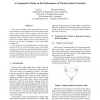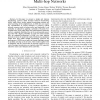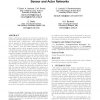159 search results - page 3 / 32 » Optimal dynamic sleep time control in Wireless Sensor Networ... |
ACISICIS
2007
IEEE
13 years 12 months ago
2007
IEEE
To increase the lifetime of the sensor networks, a recognized method is to switch off/on some sensor nodes between “sleep” and “activity” mode in order to save the energy....
INFOCOM
2006
IEEE
13 years 11 months ago
2006
IEEE
— In this paper we present a simple and stateless broadcasting protocol called Dynamic Delayed Broadcasting (DDB) which allows locally optimal broadcasting without any prior know...
INFOCOM
2006
IEEE
13 years 11 months ago
2006
IEEE
— We address the problem of energy efficient sensing by adaptively coordinating the sleep schedules of sensor nodes while guaranteeing that values of sleeping nodes can be recov...
MOBIHOC
2008
ACM
14 years 5 months ago
2008
ACM
Sensor networks are expected to evolve into long-lived, autonomous networked systems whose main mission is to provide in-situ users ? called actors ? with real-time information in...
CORR
2006
Springer
13 years 5 months ago
2006
Springer
Coverage and connectivity issues of three-dimensional (3D) networks are addressed in [2], but that work assumes that a node can be placed at any arbitrary location. In this work, ...



